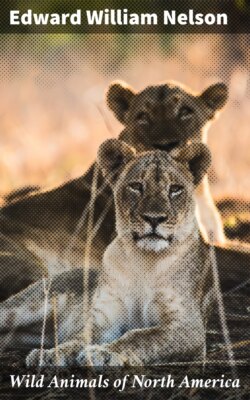Читать книгу Wild Animals of North America - Edward William Nelson - Страница 18
На сайте Литреса книга снята с продажи.
RACCOON (Procyon lotor and its subspecies)
ОглавлениеTable of Contents
Few American wild animals are more widely known or excite more popular interest than the raccoon. It is a short, heavily built animal with a club-shaped tail, and with hind feet that rest flat on the ground, like those of a bear, and make tracks that have a curious resemblance to those of a very small child. Its front toes are long and well separated, thus permitting the use of the front feet with almost the facility of a monkey’s hands.
Raccoons occupy most of the wooded parts of North America from the southern border of Canada to Panama, with the exception of the higher mountain ranges. In the United States they are most plentiful in the Southeastern and Gulf States and on the Pacific coast. Under the varying climatic conditions of their great range a number of geographic races have developed, all of which have a close general resemblance in habits and appearance.
They everywhere seek the wooded shores of streams and lakes and the bordering lowland forests and are expert tree-climbers, commonly having their dens in hollow trees, often in cavities high above the ground. In such retreats they have annually from four to six young, which continue to frequent this retreat until well grown, thus accounting for the numbers often found in the same cavity. Although tree-frequenting animals, the greater part of their activities is confined to the ground, especially along the margins of water-courses. While almost wholly nocturnal in habits, they are occasionally encountered abroad during the day.
Their diet is extraordinarily varied, and includes fresh-water clams, crawfish, frogs, turtles, birds and their eggs, poultry, nuts, fruits, and green corn. When near water they have a curious and unique habit of washing their food before eating it. Their fondness for green corn leads them into frequent danger, for when bottom-land cornfields tempt them away from their usual haunts raccoon hunting with dogs at night becomes an especially favored sport.
Raccoons are extraordinarily intelligent animals and make interesting and amusing pets. During captivity their restless intelligence is shown by the curiosity with which they carefully examine every strange object. They are particularly attracted by anything bright or shining, and a piece of tin fastened to the pan of a trap serves as a successful lure in trapping them.
They patrol the border of streams and lakes so persistently that where they are common they sometimes make well-trodden little trails, and many opened mussel shells or other signs of their feasts may be found on the tops of fallen logs or about stones projecting above the water. In the northern part of their range they hibernate during the coldest parts of the winter, but in the South are active throughout the year.
Raccoons began to figure in our frontier literature at an early date. “Coon-skin” caps, with the ringed tails hanging like plumes, made the favorite headgear of many pioneer hunters, and “coon skins” were a recognized article of barter at country stores. Now that the increasing occupation of the country is crowding out more and more of our wild life, it is a pleasure to note the persistence with which these characteristic and interesting animals continue to hold their own in so much of their original range.
